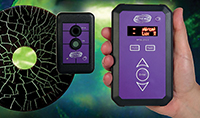UV light measurement
24/09/2018
Over the last three years, the NDT industry has adopted new standards for LED blacklights, authored by ASTM (ie ASTM E3022-15) and the Primes (ie Rolls-Royce RRES 90061 and Airbus AITM6-1001), to ensure that the properties and quality of the UV lights used are suitable for NDT inspections. In its product portfolio, Labino has UV lights that are tested to comply with all relevant ASTM, ISO and Primes requirements. The aforementioned requirements, as well as the various checklists of NDT technicians (ie Nadcap), require frequent testing and measurement of the UV lights from a distance of 15 inches (38 cm). Labino has introduced to the market what it claims is the first measurement stand for UV lights, the Olympus, especially designed to conduct measurements from a distance of 15 inches (38 cm) and help NDT professionals to remain in compliance with the relevant standards. The Olympus measurement stand comes with plates of different sizes, which enables all Labino LED blacklights (UVG Series, MB Series and BB Series) to be measured from the same distance using the Labino Apollo 1.0 UV and white light meter or any other meter.
Labino has introduced to the market what it claims is the first measurement stand for UV lights, the Olympus, especially designed to conduct measurements from a distance of 15 inches (38 cm) and help NDT professionals to remain in compliance with the relevant standards. The Olympus measurement stand comes with plates of different sizes, which enables all Labino LED blacklights (UVG Series, MB Series and BB Series) to be measured from the same distance using the Labino Apollo 1.0 UV and white light meter or any other meter.The Apollo 1.0 is an instrument for accurate measurement of UV-A irradiation and visible illuminance. Extra engineering effort has been taken to allow for the accurate measurement of visible light emission from a UV-A lamp by incorporating a superior band-pass filter containing only non-fluorescent filters. The instrument provides fast measurement capability as it offers autoranging and concurrent measuring of visible light and UV-A irradiation. It is ergonomic and easy to use due to its lightweight chassis, wireless sensor unit and compact size. The Apollo 1.0 is traceable to the USA’s National Institute of Standards and Technology (NIST).
The Apollo 1.0 comes as a single or double kit. The single kit includes one reader unit and one wireless sensor unit. The double kit includes one reader unit and two wireless sensor units. As only the sensor needs to be sent for calibration, the double kit is a convenient tool to ensure that operations are never disrupted.
Sensor measurements and transmission of data is carried out via Bluetooth. The wireless sensor enables the user to measure from distances of up to 5 m. This feature ensures that the sensor unit is stable and no movement occurs when connecting cables during measurement. Each sensor unit incorporates both the UV and white light sensors.
The meter features hold and peak functions. The hold function stores the present value measured and the peak function stores the highest value measured.
www.labino.com